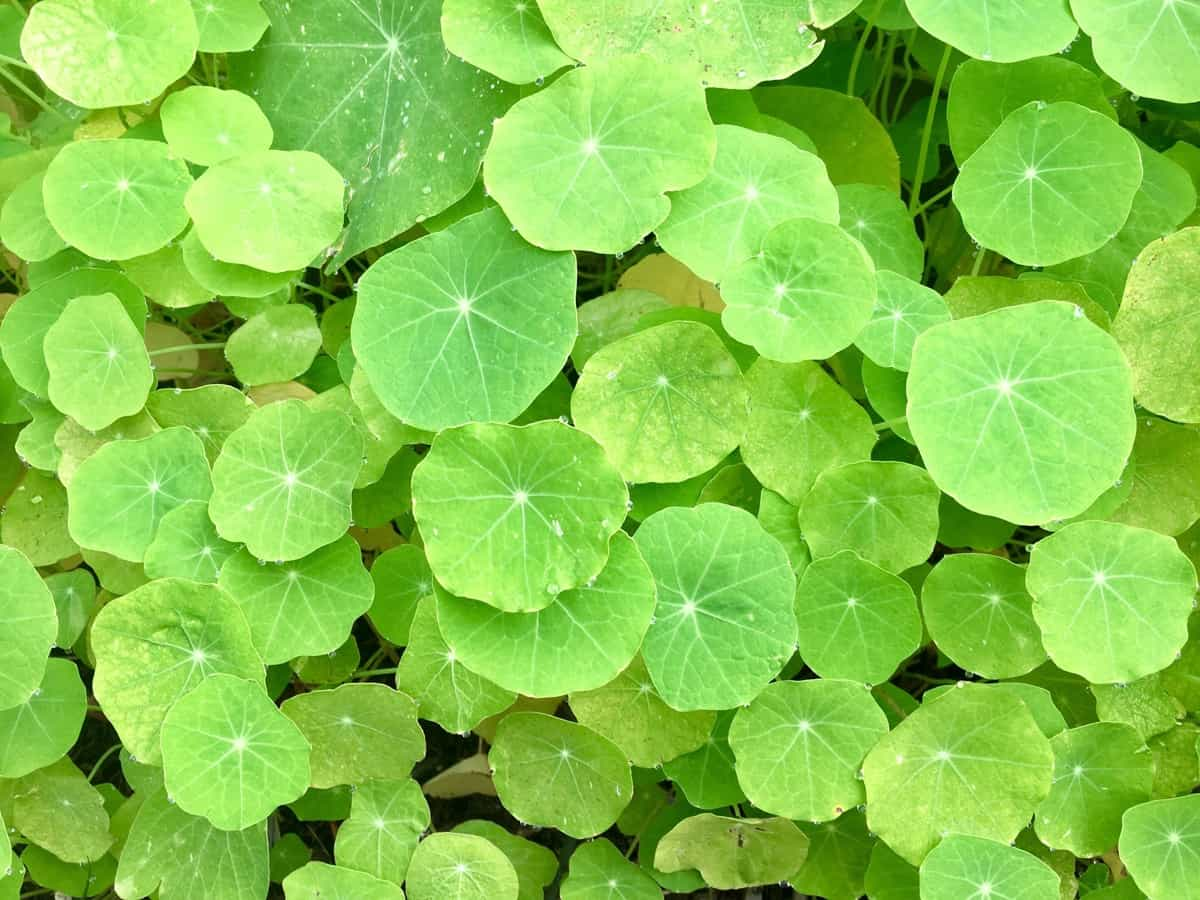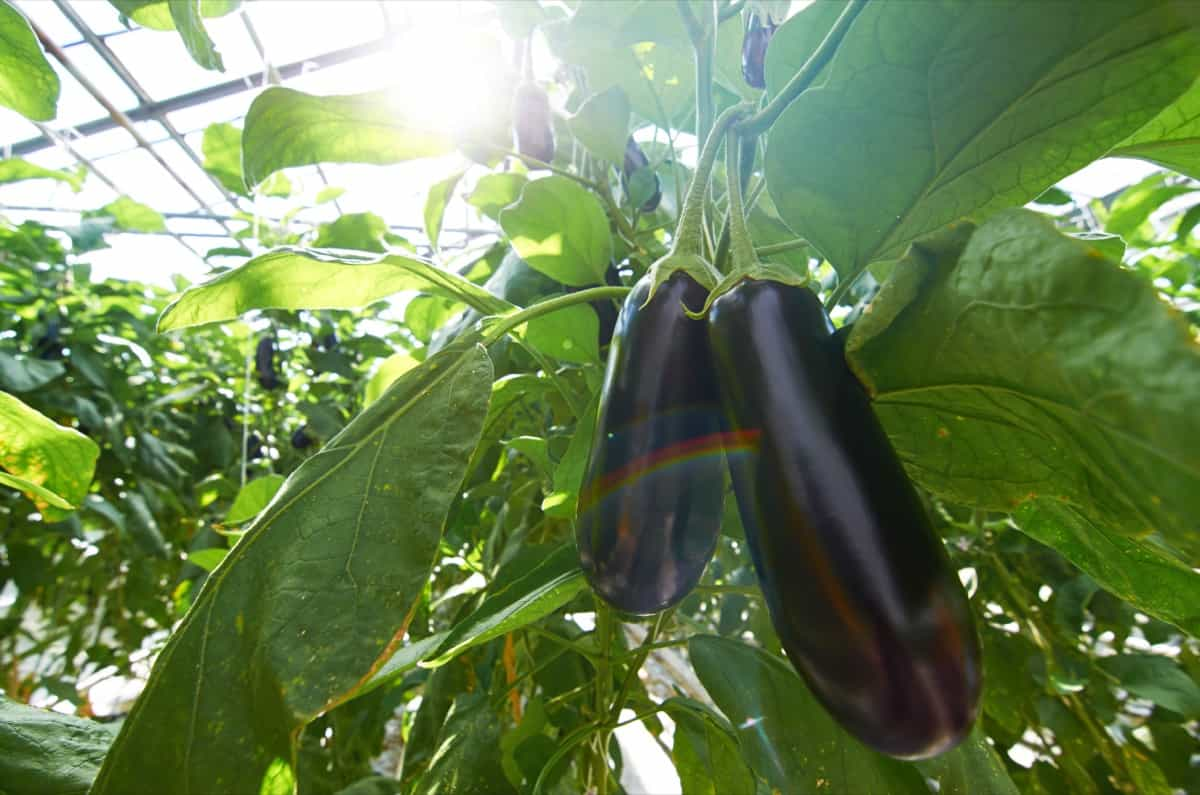Lettuce is an easy-to-grow and easy-to-harvest plant. Nothing stops you from enjoying that, regardless of the type of Lettuce you grow. If you do companion planting in your garden, you can maximize Lettuce’s growing potential and harvest.
12 Lettuce Companion Plants
Nasturtiums
Plants like Nasturtiums can help keep hungry caterpillars away from lettuce plants. Nasturtiums have a pungent smell that caterpillars, like cabbage loopers, dislike. Additionally, Nasturtiums benefit your garden because they act as trap crops for insects like black flies. However, they also attract beneficial insects like parasitic wasps and bees.

Another benefit of planting nasturtiums alongside Lettuce is that they can help improve soil quality. Nasturtiums are a cover crop that can help reduce soil erosion and improve its structure and fertility. This can lead to healthier lettuce plants with better growth and higher yields.
Asparagus
Asparagus is a crop that can continue to grow in your vegetable garden if you leave a bit of it. In this way, the plant can store enough energy for the following year. You can expect the remaining asparagus to grow tall and spread out leaves like ferns. This makes them fantastic sources of natural shade for your Lettuce, especially if it gets overexposed to the afternoon sun.
Providing shade to lettuce plants prevents their wilting, so asparagus makes a good companion plant as it prevents them from wilting. Furthermore, asparagus and Lettuce have similar nutrient requirements. Asparagus is a good nitrogen source, a vital nutrient for lettuce growth. When planted together, asparagus can provide the necessary nitrogen to lettuce plants, resulting in better growth and yield.
Beets
Beets are an excellent companion plant for Lettuce due to their many benefits. One of the main reasons beets are suitable for lettuce companion planting is that they help deter pests. Beets contain compounds that naturally repel pests like aphids and flea beetles, which can damage lettuce plants. Another benefit of planting beets alongside Lettuce is that they help to improve soil quality. Beets are known to be deep-rooted plants, which means they can access nutrients and moisture from deeper soil layers.
This, in turn, can help to improve the soil structure and make it easier for lettuce plants to grow. Additionally, beets are a good source of nutrients like potassium, which can benefit the growth and yield of lettuce plants. Furthermore, beets can also act as a natural weed barrier for Lettuce. The dense foliage of beets can help to shade the soil and prevent weed growth, which can compete with lettuce plants for nutrients and water.
Onions
You should also consider growing onions in your vegetable garden as lettuce companion plants. Lettuce and other leafy crops can benefit from onions as they deter and repel insects, including aphids and beetles. Onions have the advantage of emitting a scent that serves as a repellent. Another benefit of planting onions alongside Lettuce is that they can provide shade and shelter for the plants. This can help protect the Lettuce from the hot sun and prevent drying out. It can also help to reduce the risk of wind damage and other environmental stresses that can affect the growth and yield of lettuce plants.
Tomatoes
As a companion plant for Lettuce, tomatoes are also a good choice. In the hot summer months, tomatoes provide shade for Lettuce, preventing it from bolting or going to seed prematurely. This allows Lettuce to grow and produce for longer, resulting in a higher yield. Keeping the soil moist can ensure Lettuce and tomatoes have a productive and healthy growing season.
In case you missed it: How to Treat Powdery Mildew in Tomato Plants: A Comprehensive Identification and Control Guide

Plant lettuce seeds once your tomatoes have reached 6 inches and above in height. In addition, tomatoes and Lettuce are popular crops in home gardens, making them convenient companion plants. They are both easy to grow and require minimal maintenance, meaning they can be grown together without much effort.
Legumes
Lettuce is highly compatible with beans, peas, and legumes. Bush beans, pole beans, and other legumes will provide the addition of nitrogen to the soil. Consequently, lettuce plants will be well-nourished and grow bushy and leafy. To keep lettuce plants from wilting and bolting, tall bean plants can also provide a welcome shade. Finally, legumes can also help to attract beneficial insects to the garden. Many legumes produce flowers attractive to bees and other pollinators, which can help increase pollination rates and improve overall yields.
Strawberries
Planting strawberries and Lettuce together is a good way to use available space and interplant. Lettuce, spinach, and strawberries can increase crop productivity when planted together. Lettuce is also shade-tolerant, which means it can grow well under the shade of strawberries. This helps conserve soil moisture and reduce weed growth, benefiting both plants.
Turnips
Firstly, turnips are known for their ability to improve soil quality. They have deep roots that help them to access nutrients and moisture from deeper soil layers. As they grow, turnips break up the soil, which helps to aerate it and improve its overall texture. This makes it easier for lettuce plants to grow strong and healthy roots, which in turn leads to better growth and increased yield. Believed to deter aphids, turnips can be great companion plants for Lettuce. As root vegetables, the turnips grow mainly underground while the lettuce chills out on the surface.
Calendula
Calendula is an excellent companion plant for Lettuce. It is a member of the Marigold family, well known for its bright yellow and orange flowers. Calendula is a natural pest repellent and can help protect Lettuce from harmful insects. In addition to repelling pests, Calendula attracts beneficial insects like lacewings and ladybugs, which feed on aphids and other pests that can damage Lettuce.
This helps create a more balanced ecosystem in the garden, leading to better growth and yield for both Calendula and Lettuce. Calendula also has a beneficial effect on the soil. It is a natural fertilizer and can help improve soil fertility by adding nutrients and organic matter. This can lead to healthier lettuce plants with stronger roots and better nutrient uptake.
Eggplant
Eggplant is a summer crop, thriving in weather conditions that would be far too hot for healthy Lettuce plant eggplant near your growing Lettuce so it can take over the space after your harvest. In addition to pest control, eggplant can provide several other lettuce benefits. Eggplants have deep roots that can help to improve soil structure and nutrient uptake. They are also heavy feeders, meaning they require many nutrients to grow. By planting eggplant near your Lettuce, you can help ensure that the soil is rich and fertile, leading to better growth and yield for both crops.
In case you missed it: Frequently Asked Questions About Growing Lettuce from Seed to Harvest

Radishes
You can use fast-growing plants like radishes to mark rows of Lettuce that grow slowly—plant radishes along the row, and the radishes will germinate quickly, showing where the Lettuce will eventually grow. Meanwhile, Lettuce can make radish crops softer and more delicious longer by keeping them cool and moist.
In addition to improving soil quality, radishes also help to deter pests that can damage lettuce plants. For example, radishes emit a strong odor that repels certain insects, such as aphids and cucumber beetles, that can harm Lettuce. This means that growing radishes alongside Lettuce can help protect the crop from insect damage and increase yield.
Marigold
Marigold also attracts beneficial insects such as ladybugs and lacewings. These insects feed on aphids and other pests that can damage Lettuce and other crops. By attracting these beneficial insects, Marigold helps to keep the pest population in check, resulting in healthier Lettuce plants and a better yield. Another benefit of Marigold as a companion plant for Lettuce is its ability to improve soil health. A Marigold is a natural soil conditioner, adding nutrients to the soil as it decomposes. This can help improve the soil’s overall health, leading to better growth and yield of Lettuce.
Conclusion
In conclusion, planting companion plants with Lettuce can greatly enhance its growth and yield. These 12 lettuce companion plants are just a few examples that can help improve your lettuce crop’s health and productivity.
- Feed Your Flock for Less: Top 10 Tips to Save on Chicken Feed
- Ultimate Guide to Ossabaw Island Hog: Breeding, Raising, Diet, and Care
- Hatching Answers: The Top 10 Reasons Your Chickens Aren’t Laying Eggs
- Eggs and Economics: Breaking Down the Cost of Raising Backyard Chickens
- Defend Your Greens: Proven Methods to Keep Iguanas Out of Your Garden
- Ultimate Guide to Cinnamon Queen Chicken: A Comprehensive Guide for Beginners
- Ultimate Guide to California Tan Chicken: Breeding, Raising, Diet, Egg-Production and Care
- Ultimate Guide to Marsh Daisy Chicken: Breeding, Raising, Diet, and Care
- 10 Types of Chicken Farming Businesses You Can Start for Profits